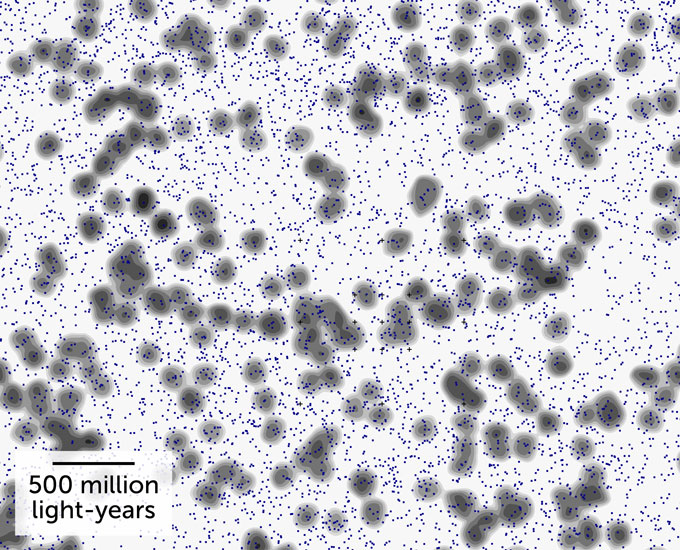A giant arc of galaxies appears to stretch across more than 3 billion light-years in the distant universe. If the arc turns out to be real, it would challenge a bedrock assumption of cosmology: that on large scales, matter in the universe is evenly distributed no matter where you look.
“It would overturn cosmology as we know it,” said cosmologist Alexia Lopez at a June 7 news conference at the virtual American Astronomical Society meeting. “Our standard model, not to put it too heavily, kind of falls through.”
Lopez, of the University of Central Lancashire in Preston, England, and colleagues discovered the purported structure, which they call simply the Giant Arc, by studying the light of about 40,000 quasars captured by the Sloan Digital Sky Survey. Quasars are the luminous cores of giant galaxies so distant that they appear as points of light. While en route to Earth, some of that light gets absorbed by atoms in and around foreground galaxies, leaving specific signatures in the light that eventually reaches astronomers’ telescopes (SN: 7/12/18).
The Giant Arc’s signature is in magnesium atoms that have lost one electron, in the halos of galaxies about 9.2 billion light-years away. The quasar light absorbed by those atoms traces out a nearly symmetrical curve of dozens of galaxies spanning about one-fifteenth the radius of the observable universe, Lopez reported. The structure itself is invisible on the sky to human eyes, but if you could see it, the arc would span about 20 times the width of the full moon.

“This is a very fundamental test of the hypothesis that the universe is homogeneous on large scales,” says astrophysicist Subir Sarkar of the University of Oxford, who studies large-scale structures in the universe but was not involved in the new work. If the Giant Arc is real, “this is a very big deal.”
But researchers aren’t convinced it is real yet. “Our eye has a tendency to pick up patterns,” Sarkar says, noting that some people have claimed to see cosmologist Stephen Hawking’s initials written in fluctuations in the cosmic microwave background, the oldest light in the universe.
Lopez ran several statistical tests to figure out the odds that galaxies would line up in a giant arc by chance. She found that there’s about a 0.3 percent chance that the structure is a statistical fluke.
That sounds pretty good, but it falls short of physicists’ gold standard threshold of 0.00003 percent, Sarkar says. “Right now, I would say they still don’t have compelling evidence,” he says. More observations, from Lopez’s group and others, could confirm or refute the Giant Arc.
If it is real, the Giant Arc would join a growing group of large-scale structures in the universe that, taken together, would break the standard model of cosmology. This model assumes that when you look at large enough volumes of space — above about 1 billion light-years — matter is distributed evenly. The Giant Arc appears about three times as long as that theoretical threshold. It joins other structures with similarly superlative names, like the Sloan Great Wall, the Giant Gamma-Ray Burst Ring and the Huge Large Quasar Group.
“We can have one large-scale structure that could just be a statistical fluke,” Lopez said. “That’s not the problem. All of them combined is what makes the problem even bigger.”
For all the latest Technology News Click Here
For the latest news and updates, follow us on Google News.

